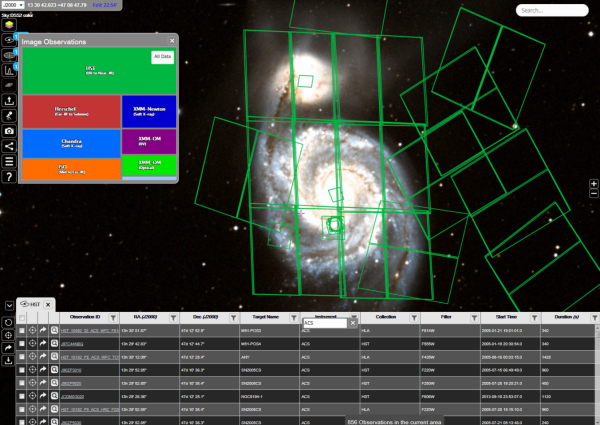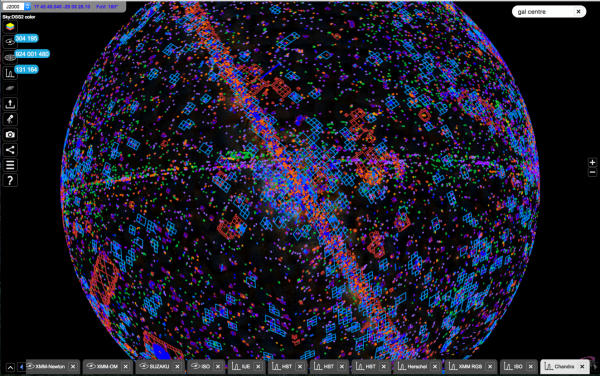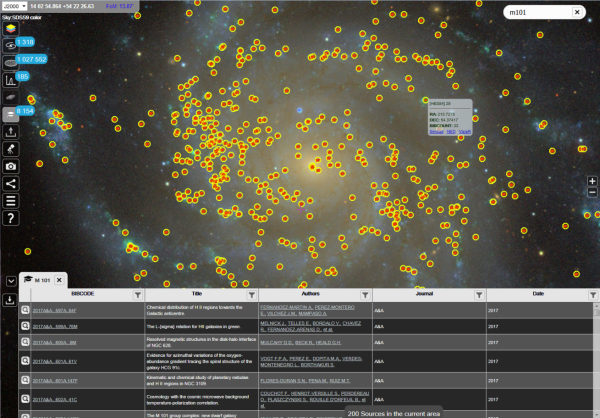Explore the cosmos with ESASky
22 March 2018
Meet ESASky, a discovery portal that provides full access to the entire sky. This open-science application allows computer, tablet and mobile users to visualise cosmic objects near and far across the electromagnetic spectrum. |
| ESASky's intuitive interface. Credit: ESA |
An innovative celestial atlas, the Internet-based application ESASky offers astronomers – professional and amateur alike – an easy way to access high-quality scientific data. It contains over half a million images, 300 000 spectra and more than one billion catalogue sources.
From gamma rays to radio wavelengths, the science-driven application allows users to explore the cosmos with data from a dozen space missions from the astronomical archives of missions in ESA's space science fleet, as well as from some missions from NASA and JAXA. ESASky requires no prior knowledge of each particular mission.
"We want to broaden access to astronomical data from ESA's sophisticated spacecraft and space telescopes, and give users the best science-ready products from each mission," says Bruno Merín, Head of the ESAC Science Data Centre at ESA's European Space Astronomy Centre (ESAC) near Madrid, Spain.
"Experts have chosen to simplify their lives, and ESASky is here to help them."
All skies in your browser
ESASky features an all-sky exploration interface. Users can easily zoom in anywhere in the sky to visualise the star, galaxy or other cosmic object of their interest and retrieve the relevant data taken in that area of the sky with just a few clicks. Moreover, they can compare observations of the same source performed in different wavelengths with different space missions. For example, far-infrared data from the Herschel Space Observatory can be combined with observations from the XMM-Newton X-ray observatory.
The tool can also be used to help prepare future observations with the NASA/ESA/CSA James Webb Space Telescope, comparing the relevant portion of the sky as observed by the NASA/ESA Hubble Space Telescope or by any of the other missions included in ESASky.
 |
| An all-inclusive astronomical atlas. Credit: ESA |
There are many options to visualise and access astronomical data with ESASky. Interactive footprints of each instrument's field of view on the sky, catalogue sources, additional information about each observation and trajectories of Solar System objects can all be combined and displayed.
The platform promotes collaborations among scientists, as users can inspect a region of the sky, share it with colleagues and download all data without having to log in or register, further simplifying the access to the data archives.
What's in it?
ESASky contains data from over one million astronomical observations collected since 1978. The cosmic sources range from planets, satellites and comets to stars, the interstellar medium that pervades our Milky Way and other galaxies beyond our own.
As of March 2018, the platform incorporates data from past and present ESA missions such as EXOSAT, Gaia, Herschel, Hipparcos, the Hubble Space Telescope, the International Ultraviolet Explorer, INTEGRAL, the Infrared Space Observatory (ISO), Planck, and XMM-Newton. It also includes data from NASA's Chandra and the NASA/JAXA Suzaku space telescopes.
The most recent version of ESASky, released last month, includes access to scientific publications.
 |
| A universe of scientific publications. Credit: ESA |
"Users can highlight on the sky all astronomical objects that are featured in scientific publications," explains Deborah Baines, Astronomy Archive Science Lead at ESAC.
"By clicking on a dedicated icon, it is possible to open the list of available publications for each object, linking directly back to the publication in the NASA Astrophysics Data System," she adds.
"This is a useful way to search for, and visually relate, scientific publications with astronomical sources."
ESASky is in continuous development. New functionalities and data sets will be added in future releases to make the application more robust and complete. The next versions will provide improved usability for mobile phones and the possibility to look for changes over time in any area of the sky that has observed more than once.
"We encourage everyone to try ESASky and dive into the cosmos with their fingertips," concludes Merín.
Notes for Editors
ESASky was launched by ESA in 2016. It is developed by the ESAC Science Data Centre (ESDC) at the European Space Astronomy Centre (ESAC) near Madrid, Spain. It works as a top-level search interface to the Astronomy Science Archives, which are developed and maintained by the ESDC, in coordination with the science operations centres and consortia of the various missions.
ESASky makes use of Aladin Lite, a lightweight sky atlas running in the browser, developed by the Centre de Données astronomiques de Strasbourg (CDS), Strasbourg Observatory, France.
For further information, please contact:
Bruno Merín
Head of the ESAC Science Data Centre
European Space Astronomy Centre (ESAC)
Villanueva de la Cañada, Spain
E-mail: Bruno.Merin![]() esa.int
esa.int
Deborah Baines
Astronomy Archive Science Lead and ESASky Product Owner
European Space Astronomy Centre (ESAC)
Villanueva de la Cañada, Spain
E-mail: deborah.baines![]() esa.int
esa.int
Fabrizio Giordano
ESASky Lead Software Engineer
European Space Astronomy Centre (ESAC)
Villanueva de la Cañada, Spain
E-mail: Fabrizio.Giordano![]() esa.int
esa.int



